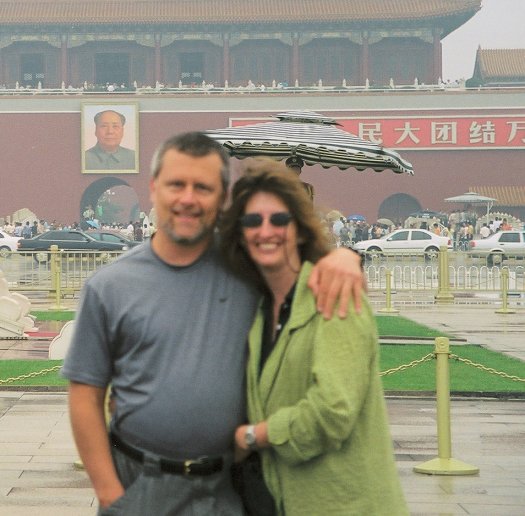Beijing:
Beijing is the capital city and has a population of around 14 million. This was the last major stop of our tour. There are many historical sites here including the Forbidden city, the summer palace, Tiananmen square, and one of the most scenic portions of the Great Wall of China.
Forbidden City:
This was imperial palace during the Ming and Qing dynasties. It is located on the north side of Tiananment square. This is the worlds largest palace complex covering over 180 acres. It is currently undergoing extensive renovation in preparation for the 2008 summer Olympics.
The building in the background is just one of many at this site. We walked through the entrance, a court yard, up some stairs to a palace building, and on the other side this is repeated about a dozen times.

Tour Group Photo:
Our tour group consisted of eight people in total. There were two Indian couples who are currently living in California. Both husbands are software programmers. The other couple live in Washington DC. The husband works for the local school board, while the wife (Patrice Hill) is a reporter for the Washington Times.

Tour Group Photo:
In all the restaurants and homes we ate in, the Chinese always served way too much food. It was their custom to keep bringing food long afer we stopped eating and were about ready to leave. They wasted so much food on us we felt guilty. What you see in this photo is the left overs after we ate our fill. It's enough for another meal. Of coarse, I wouldn't be surprised if it was served to some other people after we left.

Summer Palace:
The summer palace was constructed in the Jin Dynasty (1115-1234) and was extended many times over the years. It was a luxurious garden providing royal families with rest and entertainment. There are over 3,000 structures including pavilions, towers, bridges, and corridors.
In this photo, an artist is "painting" Chinese symbols on the pavement using a water sponge. His beautiful lettering evaporated within minutes.

Summer Palace:

Summer Palace:

Marble Boat
This boat is made entirely of marble. It was built in 1755 in Chinese style, imitating the sailing boats which Qianlong (1711-1799) took during his inspection to Southern China. The boat is 118.1 feet long, and two stories high.

Summer Palace:

Summer Palace:

Tiananmen Square:
Tiananmen square is located at the center of Beijing City. Here, you can visit Tiananmen Tower, the Monument to the People's Heroes, the Great Hall of the People, and the Mao Zedong Memorial Hall. There were huge lines of local Chinese tourists waiting to see Mao Zedongs tomb. The Chinese consider him to be a great liberator of the people since he overthrew Chiang Kai-Shek who was the last dictator. I guess they aren't aware of the fact that Mao killed over 30 million of his own people obtaining and keeping his power.

Tiananmen Square:
Our guide also knew "something about a student protest in 1989", but little else regarding the event. She has never seen the famous photo of the student facing down a tank. To this day, it is still unknown how many people were killed and injured during the uprising. A quick search on the internet produced estimates of anywhere from 400-7000 deaths.

Tiananmen Square:
Although the revolt was crushed violently, it appears to have been a wake up call to the communist government to clean up its act. Since that time, the people have been granted more and more freedoms each year, and they are moving towards a capitalistic society. The party line being fed to us by the state sponsored tour company is that the government wants to move to democracy and capitalism, but is doing so very slowly. They don't want to repeat the mistakes that Russia made by trying to reform too fast. My take on the whole thing is that they are changing just enough to keep the people happy and from revolting. Also, it's not so much about freedom as it is about prosperity. In this case, the Chinese economy is growing at around 10% per year these days, so they are very happy, despite the corruption.

Tiananmen Square:

Tiananmen Square:
